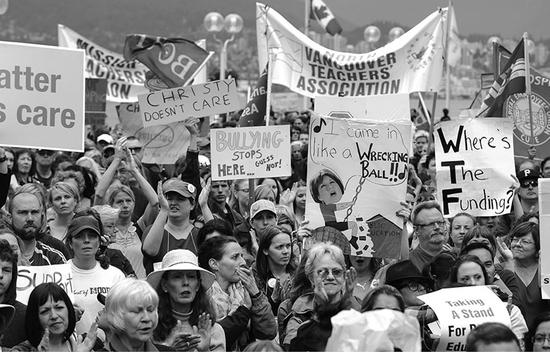22. Back to School
The extraordinary court victory by the health-care unions gave great heart to BC teachers. They too had had their contract ripped open by the Campbell government. But their court challenge to Bill 28 had been on hold while the health-care unions proceeded with their constitutional case. When Bill 29 was struck down and collective bargaining established as a constitutional right, the BCTF confidently resurrected its own challenge. Sure enough, in April 2011, more than nine years after Bill 28 had become law, BC Supreme Court Justice Susan Griffin tossed it out. The judge found that the bill violated the teachers’ charter right to collective bargaining and was aimed at saving the government an estimated $275 million a year rather than improving the education system. She gave the province a year to rectify the situation.
Instead, the government embarked on a “consultation” process with the BCTF that involved its own remedy to the Griffin decision: a three-year $165 million “Learning Improvement Fund” to address class composition issues. This didn’t come close to meeting the class size and composition strictures teachers had before Bill 28. The teachers fought back with a full year of job action involving a ban on such administrative responsibilities as report cards, staff meetings and playground supervision, and a three-day province-wide strike. In the midst of it all, the government trod its well-worn path to legislation.
Introduced in March 2012, Bill 22 banned further job action until September, imposing a mediation process that specifically prohibited improvements in wages and class size. With hostility between the two sides such that they could barely be in the same room together, mediator Charles Jago described his task as “mission impossible.” But at the end of the troubled school year, having achieved some improvement in benefits and seniority, fatigued members of the BCTF reluctantly accepted a two-year agreement largely on the government’s terms. Further confrontation was put off until the next round of contract talks.
In 2013 the BCTF presidency passed from Susan Lambert to Jim Iker, a teacher from the small north-central BC community of Topley. Under his leadership, the teachers would be severely tested once again, tossed about by a roller coaster of good and bad news and challenged by an exceptionally difficult strike. Their hopes for catch-up wages were hampered early on by modest agreements negotiated by other public sector unions in late 2013 and into 2014. The Health Sciences Association settled first, followed by the BCGEU and most of the rest of the public sector. Reached before their current contracts expired, the agreements provided a 5.5 percent wage increase over five years plus a formula that promised a bit more money if the BC economy surpassed projections. (In fact, this did produce an extra 1.25 percent over the contract’s first three years.)
The unions felt long-term stability outweighed minimal pay hikes. With public-sector unions and their pension plans under mounting pressure across Canada, the new contracts guaranteed no concessions or pension plan reductions for the next five years. But the wage pattern was set. As much as teachers argued for a substantial wage increase, given how far their salaries had fallen behind those in other provinces, there was virtually no chance of breaking the previously set wage pattern for the public sector. It would take the BCTF a long time to accept this.
When contract talks stalled, with the parties predictably far apart, the BCTF embarked on its familiar pattern of job action: a ban on administrative duties, followed by rotating walkouts, then a province-wide strike. This time there was a difference. Premier Christy Clark had been the unexpected winner of the 2013 election after the NDP and its leader Adrian Dix squandered a huge lead in the polls. Part of her election platform was a promised “ten-year deal” for teachers. To pursue this pipe dream, she and her new education minister Peter Fassbender took control of bargaining from school trustees. Peter Cameron was swiftly appointed as the government’s lead negotiator to front the tough approach. This was the same Cameron who had spent years as a leader of the militant, independent Canadian union CAIMAW before engineering the 1993 social accord with BC health-care unions as a public servant in the NDP government.
When teachers launched their first minimal job action, the government cut off their benefits and began deducting 10 percent from their paycheques. Fassbender made it clear the government had no intention of legislating an end to the dispute. Regardless, with ten days left in the school year, the BCTF launched a full-scale walkout on June 17, 2014. Veteran mediators Vince Ready and Stephen Kelleher both rejected invitations to become involved, concluding there was insufficient inclination by either party to bridge the gap between them, the cumulative result of more than thirteen years of fractious dealings.
Complicating negotiations was another court victory by the BCTF at the beginning of 2014. The same BC Supreme Court judge who struck down Bill 28 threw out its successor, Bill 22. Justice Susan Griffin found the Liberals had not only failed to meet the court’s mandate to bargain class size and class composition in good faith, they had strategically tried to provoke the BCTF into a strike to win public support for a legislated settlement. She ordered the old 2002 class size limits back into the contract and fined the government $2 million for its failure to address her previous decision. It was a stinging rebuke, but the government managed to get the judgment stayed while it appealed Justice Griffin’s no-nonsense ruling. Given the cost implications, the government preferred to take its chances with the Court of Appeal rather than reach an expensive deal at the bargaining table.
After a summer break, BCTF picket lines went back up August 25. The biggest stumbling block remained the never-ending fight over class size and composition. Teachers argued passionately that smaller classrooms and more assistance for students with special needs were better for their workload and the quality of education. As the strike continued past the opening of school on September 3, the BCTF ran out of strike pay. Similar to its support for the IWA in 1986, the labour movement pitched in with $8 million in loans to ensure teachers would not be forced back to work by lack of money. Still, the mood on the picket line was tense.

When the government spurned Jim Iker’s desperate call for binding arbitration, backed by 99.4 percent of a worried membership, it began to seem as if the province’s half a million students would never be back in school without the BCTF running up a white flag. In mid-September, however, the government began to feel pressure from exasperated parents. Sparked by a chance encounter with CLC president Hassan Yussuff, Premier Christy Clark met face-to-face with Yussuff and Jim Iker. The logjam was broken. Over a weekend, the government withdrew a contentious proposal that would have undone the teachers’ court successes, increased the money to settle past grievances and agreed to a new education fund for hiring more teachers. The teachers accepted the government’s small wage package, spread over a record six years. Early on the morning of September 16, they had a deal. Resignedly and with a sense of relief, teachers voted more than 85 percent to end their demanding five-week strike, by far the longest in their history. High school teacher Nick Smith spoke for many when he told The Globe and Mail, “It isn’t great, but for most of us, it’s good enough.”
With classrooms reopened, both sides waited for the courts to resolve the teachers’ Herculean struggle for class size and composition limits once and for all. The next round went to the government. Singling out Justice Susan Griffin for searing criticism, the BC Court of Appeal overturned her finding that the government had failed to bargain in good faith, ruling that Bill 22 was a justified use of legislation. The decision was not unanimous. Ian Donald, the senior member of the BC Court of Appeal, who long ago as a labour lawyer had won SORWUC’s historic victory that banks could be organized branch by branch, issued a vigorous, meticulously argued dissent. “[If] the government could declare all further compromise in any context to be untenable, pass whatever it wants, and spend all ‘consultation’ periods repeatedly saying ‘sorry, this is as far as we can go,’ [that] would make a mockery of the concept of collective bargaining,” Donald wrote.

On November 10, 2016, the matter came before the Supreme Court of Canada for a final verdict. After a morning of argument, the court spent a mere twenty minutes considering its decision before returning to the courtroom and delivering a quick oral judgment. By 7–2, the court rejected the judgment of the BC Court of Appeal and restored Justice Griffin’s finding “substantially for the reasons of Justice Donald.” Class size and composition limits were back in the teachers’ contract for the first time since 2002. It was a total victory for the province’s teachers, and a resounding defeat for a government that had spent so many years stifling the teachers’ right to free collective bargaining. For those in the courtroom and teachers watching back in BC, there was a moment of stunned silence, before an outpouring of joy. Along with the cheers, many tears were shed by those who had fought so long and hard for their rights as a union against a resolute, anti-union government.

This time, the government didn’t fool around. Complex negotiations to restore the 2002 contract language concluded in March 2017. To cope with smaller classrooms, the government committed to hiring twenty-six hundred new teachers, at an estimated cost of $330 million. “It took fifteen years, but we are now on the verge of having our language back and restoring what was wrongfully taken away,” said new BCTF president Glen Hansman as he thanked teachers for their unwavering tenacity. It was fought in different ways, in a different time, but the teachers’ long battle for their rights could stand with any of the noble confrontations of BC labour’s rich past.
